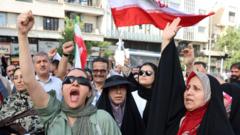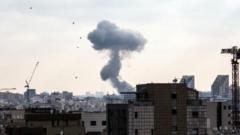A U.S. military operation has reportedly targeted ventilation shafts at Iran's Fordo nuclear enrichment site, aiming to exploit structural weaknesses. While some officials claim the facility has been severely damaged, assessments vary regarding the effectiveness of the strikes and the potential implications for U.S.-Iran relations.
U.S. Airstrike on Iran's Fordo Nuclear Facility: Analysis of Damage and Operational Strategy

U.S. Airstrike on Iran's Fordo Nuclear Facility: Analysis of Damage and Operational Strategy
Recent U.S. airstrikes targeting the Fordo nuclear facility in Iran appear to focus on specific vulnerabilities, potentially reshaping the ongoing geopolitical landscape regarding nuclear proliferation.
---
Recent satellite imagery analysis indicates that U.S. military strikes targeted strategic ventilation shafts at the Fordo nuclear enrichment facility in Iran, with implications for future international relations concerning nuclear weapons. An examination by nuclear experts has identified these shafts as potential vulnerabilities, which the U.S. appears to have aimed at during the airstrikes.
In late June 2025, reports emerged suggesting that the U.S. deployed six B-2 bombers, dropping twelve 30,000-pound bombs on the facility located underground. Experts indicate that striking such ventilation points disrupts the structural integrity of the facility, which might hinder any subsequent nuclear activities. Mark Fitzpatrick, an expert from the International Institute for Strategic Studies, noted that “hitting a ventilation shaft would make sense” for its strategic impact.
While President Trump asserted that Iran's nuclear capabilities were "completely obliterated," assessments from U.S. and Israeli military sources have been more measured, suggesting that while damage was sustained, the facility may not have been entirely neutralized. This discrepancy highlights ongoing tensions and the complexity surrounding future evaluations of Iran's nuclear status.
Satellite images captured by Maxar Technologies following the attack show evidence of debris around Fordo while core support buildings remain intact. This suggests that the primary focus of the U.S. assault was to incapacitate the underground structures associated with the nuclear program. Experts align in their views that the U.S. military's targeting of specific vulnerabilities implies the use of active intelligence on the site.
Further examining preparations before the attack, satellite data revealed unusual activity around the Fordo tunnel entrances, including the presence of cargo trucks and heavy machinery. Reports from the days leading to the strikes showed rapid changes, with earth filling the tunnel entrances, potentially reflecting measures taken by Iran to obscure critical infrastructure from aerial attacks.
As the situation continues to evolve, the broader regional implications of this targeted military action point to heightened uncertainty in U.S.-Iran relations and the global discourse on nuclear weapons, further underscoring the delicate balance of power in the area. The complexity of these dynamics will undoubtedly continue to draw attention as assessments of the operation unfold.
Recent satellite imagery analysis indicates that U.S. military strikes targeted strategic ventilation shafts at the Fordo nuclear enrichment facility in Iran, with implications for future international relations concerning nuclear weapons. An examination by nuclear experts has identified these shafts as potential vulnerabilities, which the U.S. appears to have aimed at during the airstrikes.
In late June 2025, reports emerged suggesting that the U.S. deployed six B-2 bombers, dropping twelve 30,000-pound bombs on the facility located underground. Experts indicate that striking such ventilation points disrupts the structural integrity of the facility, which might hinder any subsequent nuclear activities. Mark Fitzpatrick, an expert from the International Institute for Strategic Studies, noted that “hitting a ventilation shaft would make sense” for its strategic impact.
While President Trump asserted that Iran's nuclear capabilities were "completely obliterated," assessments from U.S. and Israeli military sources have been more measured, suggesting that while damage was sustained, the facility may not have been entirely neutralized. This discrepancy highlights ongoing tensions and the complexity surrounding future evaluations of Iran's nuclear status.
Satellite images captured by Maxar Technologies following the attack show evidence of debris around Fordo while core support buildings remain intact. This suggests that the primary focus of the U.S. assault was to incapacitate the underground structures associated with the nuclear program. Experts align in their views that the U.S. military's targeting of specific vulnerabilities implies the use of active intelligence on the site.
Further examining preparations before the attack, satellite data revealed unusual activity around the Fordo tunnel entrances, including the presence of cargo trucks and heavy machinery. Reports from the days leading to the strikes showed rapid changes, with earth filling the tunnel entrances, potentially reflecting measures taken by Iran to obscure critical infrastructure from aerial attacks.
As the situation continues to evolve, the broader regional implications of this targeted military action point to heightened uncertainty in U.S.-Iran relations and the global discourse on nuclear weapons, further underscoring the delicate balance of power in the area. The complexity of these dynamics will undoubtedly continue to draw attention as assessments of the operation unfold.























